brakes Lancia Thesis 2006 Owner handbook (in English)
[x] Cancel search | Manufacturer: LANCIA, Model Year: 2006, Model line: Thesis, Model: Lancia Thesis 2006Pages: 386, PDF Size: 8.69 MB
Page 78 of 386
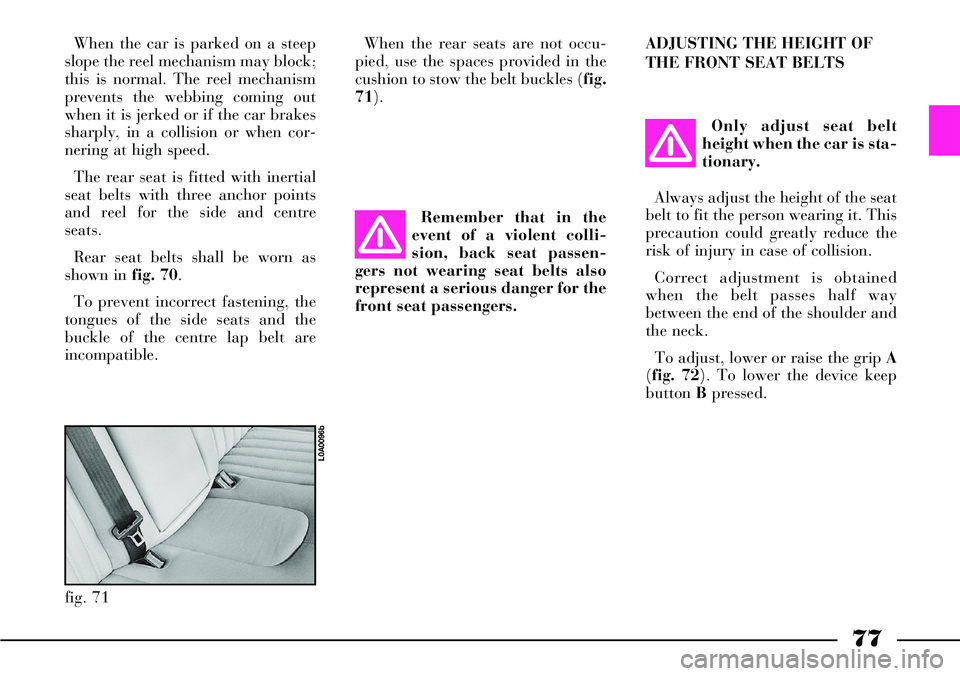
77
When the car is parked on a steep
slope the reel mechanism may block;
this is normal. The reel mechanism
prevents the webbing coming out
when it is jerked or if the car brakes
sharply, in a collision or when cor-
nering at high speed.
The rear seat is fitted with inertial
seat belts with three anchor points
and reel for the side and centre
seats.
Rear seat belts shall be worn as
shown in fig. 70.
To prevent incorrect fastening, the
tongues of the side seats and the
buckle of the centre lap belt are
incompatible.
fig. 71
L0A0096b
When the rear seats are not occu-
pied, use the spaces provided in the
cushion to stow the belt buckles (fig.
71).
Remember that in the
event of a violent colli-
sion, back seat passen-
gers not wearing seat belts also
represent a serious danger for the
front seat passengers.ADJUSTING THE HEIGHT OF
THE FRONT SEAT BELTS
Only adjust seat belt
height when the car is sta-
tionary.
Always adjust the height of the seat
belt to fit the person wearing it. This
precaution could greatly reduce the
risk of injury in case of collision.
Correct adjustment is obtained
when the belt passes half way
between the end of the shoulder and
the neck.
To adjust, lower or raise the grip A
(fig. 72). To lower the device keep
button Bpressed.
Page 176 of 386

ELECTRIC PARKING BRAKE
(EPB) (fig. 133)
The car is fitted with the EPB
(Electric Parking Brake) that cuts in
when switching the engine off and
will cut out when starting the engine
and pressing the accelerator pedal
(for manual gearbox versions when
releasing the clutch pedal at the
same time). The EPB can also be
disengaged manually by pressing
button Aset on the central console
with engine running or ignition key
to MAR.
After disengaging the EPB manual-
ly, when opening the driver’s door
the EPB will re-engage automatical-
ly, press button Aagain to disengage
it.The button shape is rather large so
the brake can be engaged rapidly,
even by the passenger, in case of
emergency.
The advantages of this system, com-
pared to the usual lever, are several:
– no effort should be made to
engage and disengage the parking
brake
– the parking brake efficiency is
always at top level in any using con-
dition, contrary to the lever which
guarantees the car complete stop only
when fully lifted
– the EPB is controlled by electric
wires, therefore all problems regard-
ing transmission cables, such as
adjustments, freezing or tears, no
longer exist
– improved safety as a result of the
sophisticated electronic control sys-
tem, similar to the ABS one, prevent-
ing wheels from blocking if the park-
ing brake is engaged during driving
– improved safety when the car is
stationary and children are left
inside the car; in this case the brake
cannot be disengaged if the ignition
key is at STOPor removed– it has automatic functions that
other systems lack.
When the parking brake is engaged
and the ignition key is at MAR, the
instrument panel warning light x
turns on.
This warning light turns on when
the parking brake reaches its highest
working level, and it turns off when
the brake is disengaged and com-
pletely released. Unlike usual park-
ing brakes, whose warning light
turns on even when the lever is lift-
ed a little bit, the EPB system warn-
ing light turns on only when the car
has come to a complete stop.
When the brake is engaged, a typi-
cal noise can be heard by the driver;
the parking brake is completely
engaged or disengaged when the
operating noise stops.
fig. 133
L0A0197b
When engaging the park-
ing brake keep the brake
pedal always depressed.
175
Page 177 of 386
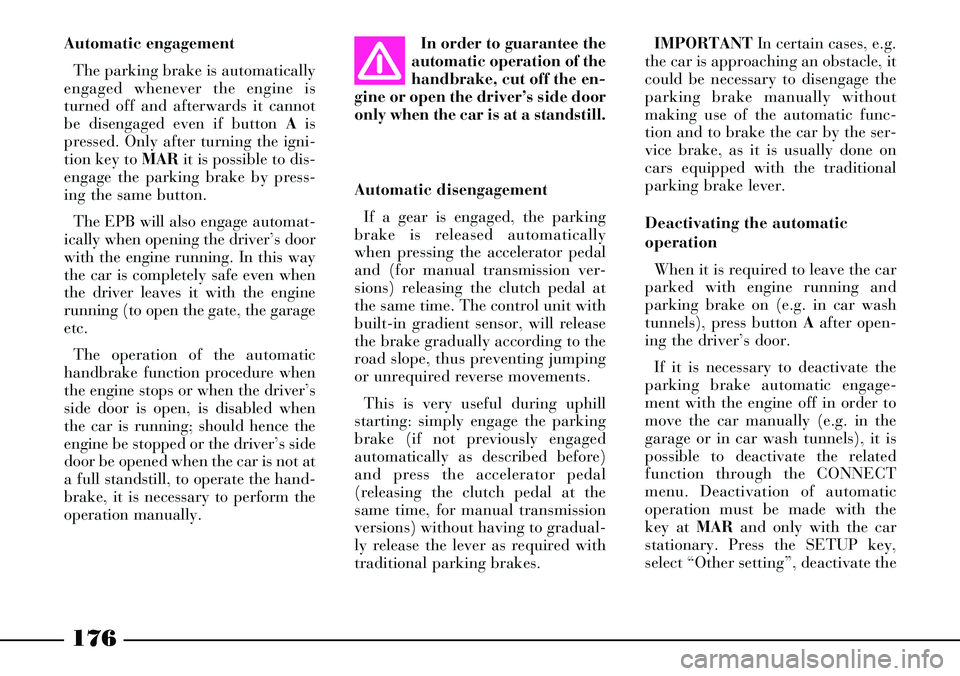
176
Automatic engagement
The parking brake is automatically
engaged whenever the engine is
turned off and afterwards it cannot
be disengaged even if button Ais
pressed. Only after turning the igni-
tion key to MARit is possible to dis-
engage the parking brake by press-
ing the same button.
The EPB will also engage automat-
ically when opening the driver’s door
with the engine running. In this way
the car is completely safe even when
the driver leaves it with the engine
running (to open the gate, the garage
etc.
The operation of the automatic
handbrake function procedure when
the engine stops or when the driver’s
side door is open, is disabled when
the car is running; should hence the
engine be stopped or the driver’s side
door be opened when the car is not at
a full standstill, to operate the hand-
brake, it is necessary to perform the
operation manually.Automatic disengagement
If a gear is engaged, the parking
brake is released automatically
when pressing the accelerator pedal
and (for manual transmission ver-
sions) releasing the clutch pedal at
the same time. The control unit with
built-in gradient sensor, will release
the brake gradually according to the
road slope, thus preventing jumping
or unrequired reverse movements.
This is very useful during uphill
starting: simply engage the parking
brake (if not previously engaged
automatically as described before)
and press the accelerator pedal
(releasing the clutch pedal at the
same time, for manual transmission
versions) without having to gradual-
ly release the lever as required with
traditional parking brakes.IMPORTANTIn certain cases, e.g.
the car is approaching an obstacle, it
could be necessary to disengage the
parking brake manually without
making use of the automatic func-
tion and to brake the car by the ser-
vice brake, as it is usually done on
cars equipped with the traditional
parking brake lever.
Deactivating the automatic
operation
When it is required to leave the car
parked with engine running and
parking brake on (e.g. in car wash
tunnels), press button Aafter open-
ing the driver’s door.
If it is necessary to deactivate the
parking brake automatic engage-
ment with the engine off in order to
move the car manually (e.g. in the
garage or in car wash tunnels), it is
possible to deactivate the related
function through the CONNECT
menu. Deactivation of automatic
operation must be made with the
key at MARand only with the car
stationary. Press the SETUP key,
select “Other setting”, deactivate the In order to guarantee the
automatic operation of the
handbrake, cut off the en-
gine or open the driver’s side door
only when the car is at a standstill.
Page 190 of 386

189
If these rules are not
respected, the automatic
gearbox might be severely
damaged.
The car can be towed only for
short distances and at a low
speed: if it is necessary to tow it
for a longer distance, raise the
driving wheels so that the gear-
box is not dragged during towing. TOWING THE CAR
IMPORTANTTo tow the car
observe local current laws and fol-
low the instructions contained in
chapter “In an emergency”.
If the car must be towed, observe
the following precautions:
– if possible, transfer the car on a
towtruck
– otherwise, tow the car by raising
the front driving wheels
– even if the latter solution is not
possible, the car can be towed for
less than 50 Km at a speed of 50
km/h.
Towing shall be performed with
gear lever to N.Before starting towing,
disengage the parking
brake as described in the
relevant paragraph and leave the
Keyless System CID (if any) in the
passenger’s compartment to pre-
vent automatic steering lock. Do
not tow the car with the engine
running.
ESP AND ASR
SYSTEMS
ESP SYSTEM (ELECTRONIC
STABILITY PROGRAM):
GENERAL
ESP is an electronic system con-
trolling the car stability which
affects the driving torque and brakes
the wheels in a different way in case
of grip loss, thus making the car
recover the right driving direction.
During driving the car is subject to
side and longitudinal forces which
can be controlled by the driver until
tire grip is acceptable. When the lat-
ter is lower than the minimum level,
the car starts skidding.
If the road bed is uneven (bumpy
road, presence of ice, mould, etc.)
tyre grip is considerably reduced. In
these conditions, when extreme
manoeuvres are made, the car might
start skidding.
Page 191 of 386
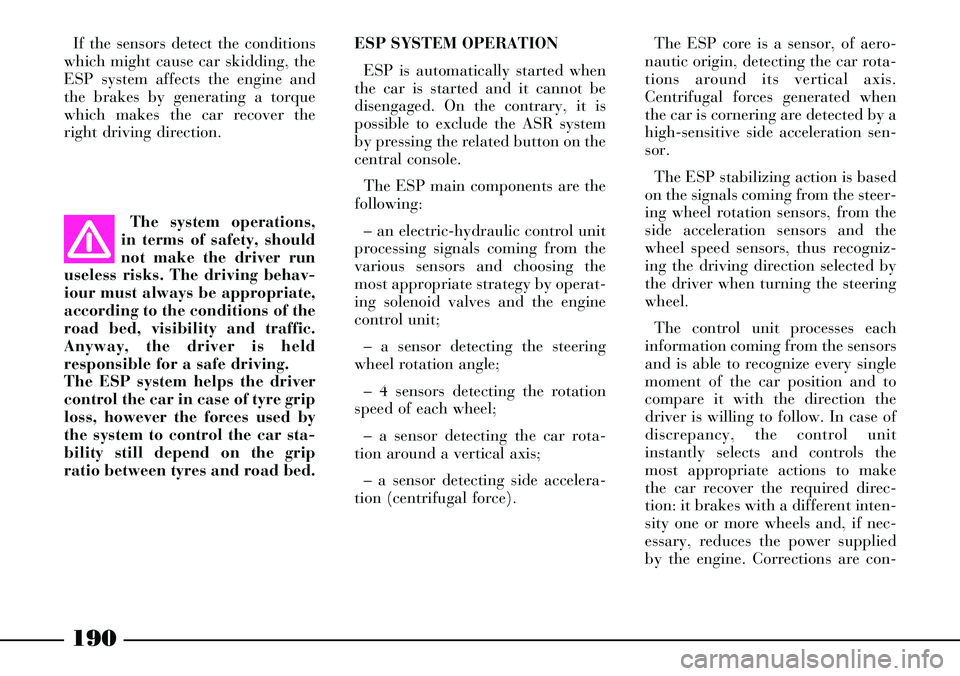
190
If the sensors detect the conditions
which might cause car skidding, the
ESP system affects the engine and
the brakes by generating a torque
which makes the car recover the
right driving direction.
The system operations,
in terms of safety, should
not make the driver run
useless risks. The driving behav-
iour must always be appropriate,
according to the conditions of the
road bed, visibility and traffic.
Anyway, the driver is held
responsible for a safe driving.
The ESP system helps the driver
control the car in case of tyre grip
loss, however the forces used by
the system to control the car sta-
bility still depend on the grip
ratio between tyres and road bed.ESP SYSTEM OPERATION
ESP is automatically started when
the car is started and it cannot be
disengaged. On the contrary, it is
possible to exclude the ASR system
by pressing the related button on the
central console.
The ESP main components are the
following:
– an electric-hydraulic control unit
processing signals coming from the
various sensors and choosing the
most appropriate strategy by operat-
ing solenoid valves and the engine
control unit;
– a sensor detecting the steering
wheel rotation angle;
– 4 sensors detecting the rotation
speed of each wheel;
– a sensor detecting the car rota-
tion around a vertical axis;
– a sensor detecting side accelera-
tion (centrifugal force).The ESP core is a sensor, of aero-
nautic origin, detecting the car rota-
tions around its vertical axis.
Centrifugal forces generated when
the car is cornering are detected by a
high-sensitive side acceleration sen-
sor.
The ESP stabilizing action is based
on the signals coming from the steer-
ing wheel rotation sensors, from the
side acceleration sensors and the
wheel speed sensors, thus recogniz-
ing the driving direction selected by
the driver when turning the steering
wheel.
The control unit processes each
information coming from the sensors
and is able to recognize every single
moment of the car position and to
compare it with the direction the
driver is willing to follow. In case of
discrepancy, the control unit
instantly selects and controls the
most appropriate actions to make
the car recover the required direc-
tion: it brakes with a different inten-
sity one or more wheels and, if nec-
essary, reduces the power supplied
by the engine. Corrections are con-
Page 192 of 386

191
To make ESP, ASR and
ABS systems work prop-
erly, the tyres must
absolutely be of the same brand
and type on all wheels, in perfect
conditions and, above all, of type,
brand and size specified. stantly changed and controlled in
the attempt to keep the driver’s
direction.
The ESP system considerably
increases the car safety in several
critical conditions and it is particu-
larly useful during overtaking, when
the grip conditions on the road bed
change.ASR FUNCTION (ANTISLIP
REGULATION)
General
The ASR function is part of the
ESP system and it checks the car
drive, taking action every time one
or both driving wheels slip, thus pre-
venting car instability and tyre wear.
On the basis of slipping conditions,
two different check systems are acti-
vated:
– if slipping affects both driving
wheels, as a result of the excessive
force transmitted, the ASR function
reduces the power supplied by the
engine;
– if slipping affects only one of the
driving wheels, the ASR function
automatically brakes the slipping
wheel, with an effect similar to the
self-locking differential.The action of the ASR function is
particularly useful in the following
conditions:
– internal wheel slipping when cor-
nering due to load dynamic varia-
tions and excessive acceleration;
– excessive power supplied to
wheels according to the road bed;
– acceleration on slippery ground,
covered with snow or ice;
– in case of grip loss on wet ground
(aquaplaning).
ASR function activation
The ASR function is activated
automatically whenever the engine
is started.
During driving it is possible to dis-
engage and engage this function by
pressing button A(fig. 142) on the
central console.
When the ASR function is on, sym-
bol Vis lighted on the multifunc-
tion display together with the mes-
sage “ASR ON”.
Page 202 of 386

201
Deleting the stored speed
The stored speed is automatically
deleted when:
– the engine is stopped
– ring Ais turned to OFF.
When the system is switched off,
any information shown on the
instrument panel display will be
deleted.
Maintaining speed and distance
The system will maintain the
stored speed when no vehicle is
detected along the running path. If,
on the contrary, a vehicle is detected
which runs at a low speed, the sys-
tem will automatically perform the
operations (acceleration, decelera-
tion or slight braking) required to
keep the set distance from the vehi-
cle ahead.The maximum decelera-
tion performed by the sys-
tem automatically is lim-
ited compared to the actual brak-
ing power of the brake system;
therefore, emergency braking can
and must be performed only by
the driver. A buzzer will warn the
driver that the brakes shall be
applied.Detecting a vehicle with the
system active but not switched on
When the system is active (ring A
set to any position other than OFF),
it can detect the presence of a vehi-
cle only after it has been switched on
at least once (by turning ring Bto
(+).
Subsequently, the presence of a
running vehicle will always be indi-
cated, even when the system is off,
until deactivating the system (ring A
set to OFF).
Pressing the brake pedal will
switch the system off, whereas it will
always be possible to accelerate, (e.g
for overtaking), without switching
the system off; the system will auto-
matically bring the car back to the
stored speed when the accelerator
pedal is released (provided that 160
km/h speed has not been exceeded).
The multifunction display gives to
the driver concise information on the
stored speed, the presence of a run-
ning vehicle (if any) and the set dis-
tance.
Page 212 of 386
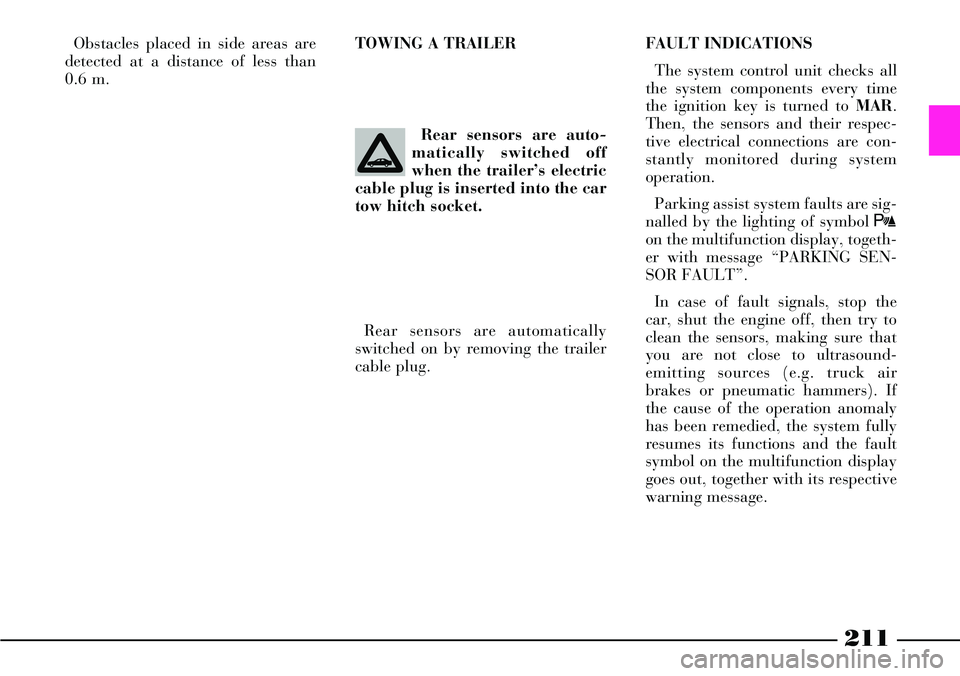
211
Obstacles placed in side areas are
detected at a distance of less than
0.6 m.
Rear sensors are automatically
switched on by removing the trailer
cable plug.FAULT INDICATIONS
The system control unit checks all
the system components every time
the ignition key is turned to MAR.
Then, the sensors and their respec-
tive electrical connections are con-
stantly monitored during system
operation.
Parking assist system faults are sig-
nalled by the lighting of symbol t
on the multifunction display, togeth-
er with message “PARKING SEN-
SOR FAULT”.
In case of fault signals, stop the
car, shut the engine off, then try to
clean the sensors, making sure that
you are not close to ultrasound-
emitting sources (e.g. truck air
brakes or pneumatic hammers). If
the cause of the operation anomaly
has been remedied, the system fully
resumes its functions and the fault
symbol on the multifunction display
goes out, together with its respective
warning message. Rear sensors are auto-
matically switched off
when the trailer’s electric
cable plug is inserted into the car
tow hitch socket.TOWING A TRAILER
Page 213 of 386
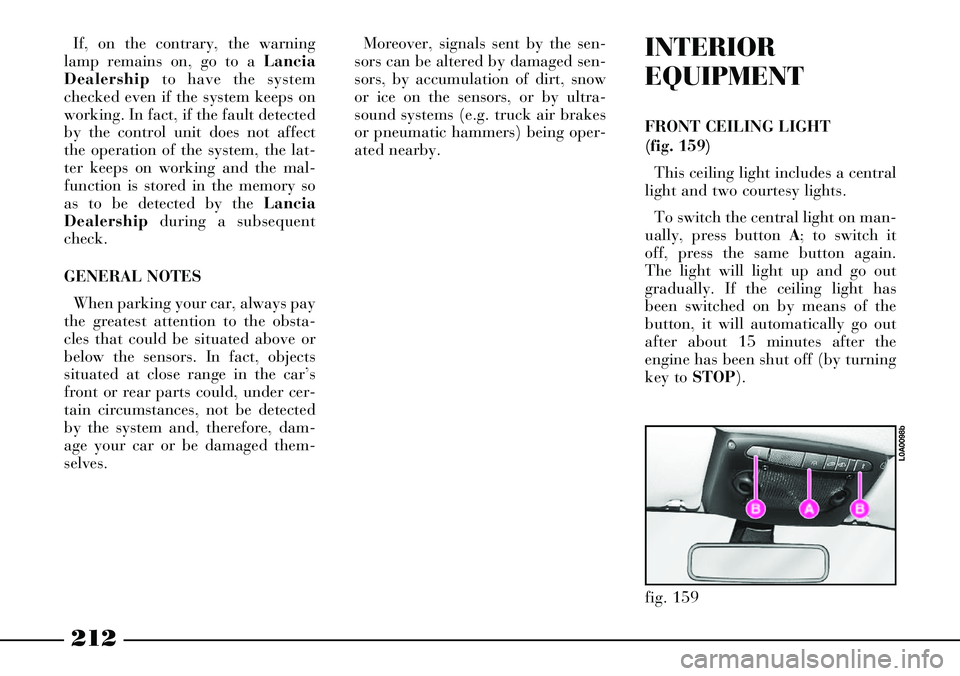
212
If, on the contrary, the warning
lamp remains on, go to a Lancia
Dealership to have the system
checked even if the system keeps on
working. In fact, if the fault detected
by the control unit does not affect
the operation of the system, the lat-
ter keeps on working and the mal-
function is stored in the memory so
as to be detected by the Lancia
Dealership during a subsequent
check.
GENERAL NOTES
When parking your car, always pay
the greatest attention to the obsta-
cles that could be situated above or
below the sensors. In fact, objects
situated at close range in the car’s
front or rear parts could, under cer-
tain circumstances, not be detected
by the system and, therefore, dam-
age your car or be damaged them-
selves.Moreover, signals sent by the sen-
sors can be altered by damaged sen-
sors, by accumulation of dirt, snow
or ice on the sensors, or by ultra-
sound systems (e.g. truck air brakes
or pneumatic hammers) being oper-
ated nearby.INTERIOR
EQUIPMENT
FRONT CEILING LIGHT
(fig. 159)
This ceiling light includes a central
light and two courtesy lights.
To switch the central light on man-
ually, press button A; to switch it
off, press the same button again.
The light will light up and go out
gradually. If the ceiling light has
been switched on by means of the
button, it will automatically go out
after about 15 minutes after the
engine has been shut off (by turning
key to STOP).
fig. 159
L0A0098b
Page 247 of 386
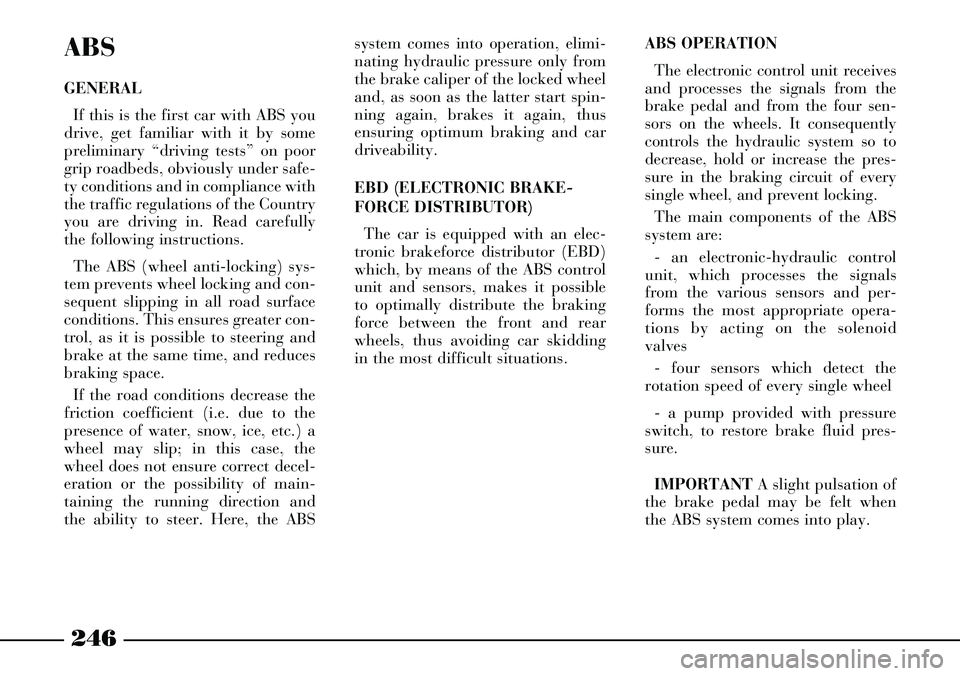
246
ABS
GENERAL
If this is the first car with ABS you
drive, get familiar with it by some
preliminary “driving tests” on poor
grip roadbeds, obviously under safe-
ty conditions and in compliance with
the traffic regulations of the Country
you are driving in. Read carefully
the following instructions.
The ABS (wheel anti-locking) sys-
tem prevents wheel locking and con-
sequent slipping in all road surface
conditions. This ensures greater con-
trol, as it is possible to steering and
brake at the same time, and reduces
braking space.
If the road conditions decrease the
friction coefficient (i.e. due to the
presence of water, snow, ice, etc.) a
wheel may slip; in this case, the
wheel does not ensure correct decel-
eration or the possibility of main-
taining the running direction and
the ability to steer. Here, the ABSsystem comes into operation, elimi-
nating hydraulic pressure only from
the brake caliper of the locked wheel
and, as soon as the latter start spin-
ning again, brakes it again, thus
ensuring optimum braking and car
driveability.
EBD (ELECTRONIC BRAKE-
FORCE DISTRIBUTOR)
The car is equipped with an elec-
tronic brakeforce distributor (EBD)
which, by means of the ABS control
unit and sensors, makes it possible
to optimally distribute the braking
force between the front and rear
wheels, thus avoiding car skidding
in the most difficult situations.ABS OPERATION
The electronic control unit receives
and processes the signals from the
brake pedal and from the four sen-
sors on the wheels. It consequently
controls the hydraulic system so to
decrease, hold or increase the pres-
sure in the braking circuit of every
single wheel, and prevent locking.
The main components of the ABS
system are:
- an electronic-hydraulic control
unit, which processes the signals
from the various sensors and per-
forms the most appropriate opera-
tions by acting on the solenoid
valves
- four sensors which detect the
rotation speed of every single wheel
- a pump provided with pressure
switch, to restore brake fluid pres-
sure.
IMPORTANTA slight pulsation of
the brake pedal may be felt when
the ABS system comes into play.